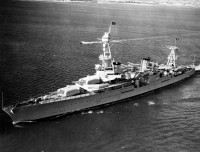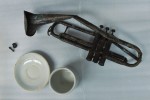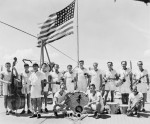 The USS Houston, a heavy cruiser that was President Franklin D. Roosevelt’s favorite ship, was the flagship of the U.S. Navy’s Asiatic Fleet not once but twice. FDR visited it no fewer than four times, logging thousands of miles of travel on board. It was even retrofitted with special elevators and handrails for the President’s disability. The Galloping Ghost of the Java Coast, as the USS Houston was known, saw its last action in a battle against a Japanese invasion fleet of 12 ships the night of February 28th, early morning March 1st, 1942. It was already hobbled from a previous action and was heading to safety in Australia alongside the HMAS Perth when it stumbled on the Japanese ships in the Sunda Strait, which separates the islands of Java and Sumatra and the Java Sea from the Indian Ocean.
The USS Houston, a heavy cruiser that was President Franklin D. Roosevelt’s favorite ship, was the flagship of the U.S. Navy’s Asiatic Fleet not once but twice. FDR visited it no fewer than four times, logging thousands of miles of travel on board. It was even retrofitted with special elevators and handrails for the President’s disability. The Galloping Ghost of the Java Coast, as the USS Houston was known, saw its last action in a battle against a Japanese invasion fleet of 12 ships the night of February 28th, early morning March 1st, 1942. It was already hobbled from a previous action and was heading to safety in Australia alongside the HMAS Perth when it stumbled on the Japanese ships in the Sunda Strait, which separates the islands of Java and Sumatra and the Java Sea from the Indian Ocean.
The Japanese fleet was in the process of landing troops on Java’s Banten Bay when the Houston and Perth walked in on them. Hopelessly outgunned and outmanned, the Perth went down first in the wee hours of March 1st. Then the Japanese ships trained all their firepower on the Houston. Finally three torpedoes struck it at once and the cruiser sank taking 650 sailors and Marines down with her, among them 11 members of its 18-man swing band. Its 368 survivors were taken prisoner by the Japanese.
 The wreck of the Houston is now 100 feet underwater just off the west coast of Jakarta. The Perth lies about three miles away. Both wrecks are official military graves and interfering with them in any way is illegal. Authorities do allow non-intrusive sport diving of the wrecks, however. They even encourage it because recreational divers are often the first to notice when something is wrong or missing. In 2013, 68-year-old Australian diver Frank Craven was diving the wrecks with a group when he noticed an incongruous trumpet amidst the piles of shell casings. With some vague notion that he might return it to the United States, Craven violated the sanctity of the site and illegally removed the trumpet and brought it to the surface.
The wreck of the Houston is now 100 feet underwater just off the west coast of Jakarta. The Perth lies about three miles away. Both wrecks are official military graves and interfering with them in any way is illegal. Authorities do allow non-intrusive sport diving of the wrecks, however. They even encourage it because recreational divers are often the first to notice when something is wrong or missing. In 2013, 68-year-old Australian diver Frank Craven was diving the wrecks with a group when he noticed an incongruous trumpet amidst the piles of shell casings. With some vague notion that he might return it to the United States, Craven violated the sanctity of the site and illegally removed the trumpet and brought it to the surface.
A week later, the trumpet drying and corroding in dangerous non-conservation conditions, Craven contacted John K. Schwarz, head of the USS Houston‘s Survivors’ Association, and offered to give the trumpet to the association. Schwarz explained that removing anything from the wreck is illegal and they could not accept the object. He suggested Craven fess up to the Navy which Schwarz did right away, apologizing for his ill-conceived act. He arranged the return of the trumpet through a US Naval Attaché in Canberra, Australia.
 In December of 2013, the trumpet and a ceramic cup and saucer Craven had also removed arrived at the Naval History & Heritage Command Underwater Archaeology Branch (UAB) in Washington, DC. After several months out of the salt water that had preserved it for seven decades, the trumpet needed immediate treatment to keep it from further corrosion. It was placed in a customized alkaline solution of deionized water to leach out the corrosive salts causing the oxidization of the trumpet’s copper and steel body. When the water became saturated with salts from the trumpet, it was replaced with fresh solution, an ongoing process that will continue until there are no salts left to leach out.
In December of 2013, the trumpet and a ceramic cup and saucer Craven had also removed arrived at the Naval History & Heritage Command Underwater Archaeology Branch (UAB) in Washington, DC. After several months out of the salt water that had preserved it for seven decades, the trumpet needed immediate treatment to keep it from further corrosion. It was placed in a customized alkaline solution of deionized water to leach out the corrosive salts causing the oxidization of the trumpet’s copper and steel body. When the water became saturated with salts from the trumpet, it was replaced with fresh solution, an ongoing process that will continue until there are no salts left to leach out.
Three years later, the trumpet still spends most of its time in the bath, but its condition has stabilized enough that conservators can take it out to perform additional conservation tasks like removing patches of oxidization with a scalpel. Here is video of Navy conservator Shanna Daniel performing that task on the trumpet from the USS Houston:
 Also part of the UAB’s brief is documenting and researching the instrument. They have discovered the trumpet’s serial number which allowed them to track its manufacturer: the C.G. Conn company of Elkhart, Indiana. Researchers hope to go further than that and maybe identify which sailor once played this trumpet. One of the 11 members of the band to lose their lives the night of the Battle of the Sunda Strait was trumpet player Severyn “Steve” Dymanowski of Gary, Indiana. Three other trumpet players — George Galyean, Albert “Hap” Kelley and Walter Schneck — who survived the sinking of the Houston were taken prisoner. They all survived the war but passed away in the 60s and 70s, alas. The trumpet could have belonged to any one of them, although the mother of pearl buttons suggest this was the expensive private instrument of a professional musician rather than Navy-issue equipment, which would make bandleader George Galyean and Hap Kelley the likeliest candidates.
Also part of the UAB’s brief is documenting and researching the instrument. They have discovered the trumpet’s serial number which allowed them to track its manufacturer: the C.G. Conn company of Elkhart, Indiana. Researchers hope to go further than that and maybe identify which sailor once played this trumpet. One of the 11 members of the band to lose their lives the night of the Battle of the Sunda Strait was trumpet player Severyn “Steve” Dymanowski of Gary, Indiana. Three other trumpet players — George Galyean, Albert “Hap” Kelley and Walter Schneck — who survived the sinking of the Houston were taken prisoner. They all survived the war but passed away in the 60s and 70s, alas. The trumpet could have belonged to any one of them, although the mother of pearl buttons suggest this was the expensive private instrument of a professional musician rather than Navy-issue equipment, which would make bandleader George Galyean and Hap Kelley the likeliest candidates.
The only way to narrow it down further is a very long shot.
There is “the possibility of examining the interior of the [trumpet’s] valves and potentially locating some DNA remains of the individual who played the trumpet,” [Navy senior conservator Kate] Morrand said in a recent interview at the Navy Yard.
It’s a long shot, but the theory is that the owner may have left his DNA when he took it apart to clean it. And, sealed in when he reassembled it and then by seven decades of marine encrustation, the DNA may still be there, Morrand said.
“If we could recover DNA, and if there are descendants that we could match with … [we could] identify who the owner of the trumpet was,” [UAB head Robert S.] Neyland said. “It kind of pushes the technology and pushes the science … but it would be pretty exciting.”
It pushes it to the breaking point, I’d think, but hey, who’d have thought they’d find Richard III under a parking lot.
Once the trumpet is fully stabilized and no longer needs to live in its bath, it will go on display in the National Museum of the U.S. Navy‘s exhibit dedicated to the USS Houston.